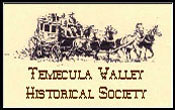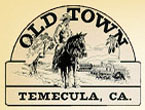| |

Local
History |
'Working
to preserve the rich heritage of the Temecula Valley' |




A
Short History of Temecula, California |
Courtesy
of the Temecula Valley Museum. Written by Phil Brigandi, Author and Historian |
Temecula
is one of the most historic communities in Southern California. From
Indian village to mission outpost, from Mexican rancho to crossroads
settlement, from railroad town to modern city, the story of Temecula
is rich and varied. Long before the first Europeans reached California,
the Luiseņo people lived in the area. They lived by hunting and gathering.
Small game, acorns, and various plant seeds formed the basis of their
diet. Life was built around the clan, an extended family group that
had its own territory, and cooperated in work and rituals. The largest
village in the area was known as Temecula, meaning "place of the
sun". (Temet is the Luiseņo word for "sun".) The Luiseņo were here when the first Spanish missionaries entered California in 1769. By the 1780's, some of the Temecula's had already been baptized at San Juan Capistrano. The first recorded visit to the valley was in 1797, when Father Fermin Lasuen, Father Serra's successor as President of California's Franciscan missions, led an exploring party over the mountains seeking a new mission site. In 1798, Father Lasuen founded the Mission San Luis Rey, near modern- day Oceanside. As the mission grew, it reached out into more and more of the interior, where outposts and ranches were established. In 1816 an asistencia (sub-mission) was founded at Pala, and by the early 1820's missionaries were farming and raising cattle at Temecula. An adobe ranch house and a long granary were built here in the 1830s. In 1834, San Luis Rey was stripped of its lands by the Mexican government, which now ruled California. To encourage settlement, the Governor of California was authorized to grant the former mission lands as ranchos to private individuals. Three grants were made in the Temecula area: the Rancho Temecula at the southern end of the valley, the Rancho Pauba to the east, and the Rancho Santa Rosa in the hills to the west. Together they totaled more than 100,000 acres. These were cattle ranches, and hides and tallow became California's principal trade items. A fourth grant of only 2,000 acres was made to Pablo Apis, one of the few former mission converts to be given a land grant. The "Little Temecula" grant, as it came to be known, included the Village of Temecula, which was then located in the Pauba Valley along the south side of Temecula Creek. Until the arrival of the railroad in the 1880s, this area (about where the Redhawk bridge now crosses the creek) was the heart of Old Temecula. Captured in the 1846 at the start of the Mexican War, California was officially ceded to the United States by Treaty of Guadalupe Hidalgo in 1848, just days before gold was discovered at Sutter's Mill. Prospectors flooded into California by land and by sea. One of the major trails crossed the Colorado River at Yuma and continued across the desert on through Temescal Canyon towards Los Angles. Tens of thousands of prospectors from the United States and Mexico, and hundreds of thousands of head of cattle and sheep poured over this "Southern Emigrant Trail" during the gold Rush. This was the route of the famous Butterfield Overland Mail, which ran from 1858-1861. The stage company established a stop in Temecula, first Pablo Apis, and then John Magee's store. Later a change station was added at "The Willows," about midway between Temecula and the Laguna Grande (Lake Elsinore). During the Butterfield days, Temecula's first post office was established, operating from 1859-1862. But the outbreak of the Civil War in 1861 spelled the end of the Butterfield, as much of the route ran through Confederate territory. After the war, other stage lines would serve Temecula until the coming railroad. In the early 1850's the old ranchos around Temecula passed into America hands. After the Civil War had destroyed much of the Southern California cotton industry, sheep began replacing cattle on many Southern California ranches. In 1873, a group of Spanish-born invertors led by Domingo Pujol bought 51,000 acres of the Temecula and Pauba ranchos, and brought down 7,000 head of sheep from their San Louis Obispo County Ezeguiel and Juan Murrieta, took the northern end of the Temecula grant where the city that bears their name now stands. The old Luiseņo Village of Temecula survived until 1875. In 1869 the local Indian Agent noted that, "There are about one hundred and fifty San Luis Rey Indians living here. There are Christians in their religious belief, and have adopted the customs, dress, and habits of the whites; have lands fences in under cultivation; owning considerable stock, goods houses, and would do well were it not for the whites and Mexicans." Under Spanish and Mexican law, the Indians held a possessory right to their lands. But American law did not see it that way. In 1869, the ranch owners seeking the removal of the Temeculas who were "unlawfully" living in their homes filed a lawsuit. In 1875 the Sheriff served an eviction notice, and game the villagers just eleven days to pack up and move out. Adobe homes, fruit trees and irrigated fields would have to be left behind. In time, a few of the Temeculas settled in Pechanga Canyon, almost with sight of their old homes, and in 1882 the Pechanga Indian Reservation was established. In 1880, construction began on the first railroad line to San Diego, the California Southern. From the coast, the tracks followed the Santa Margarita River up through the narrow Temecula Canyon, then into the valley, where they turned north towards Lake Elsinore. In 1882 the rails reached Colton, and regular service began. In 1885 the California Southern connected with the new Santa Fe line over the Cajon Pass, and for a few brief years a transcontinental railway served Temecula. But the tracks had been laid too low through Temecula Canyon, and washed out frequently. A major storm in 1884 closed the line for almost a year. After another major washout in 1891, the California Southern abandoned the canyon and left Temecula at the end of a branch line. Rail service continued until 1935. With the coming of the railroad, the center of Temecula began to shift. The railroad laid out a new Temecula townsite across the creek from the tracks, and in 1882 Simon Mundt opened the first store there. Direct access to the railroad drew more and more people away from "Old Temecula" (as the settlement up the valley came to be known). Even Louis Wolf, the merchant prince of Old Temecula, finally gave in and established a branch store in the new town, though he remained at his old adobe (which still stands) until his death in 1887. The railroad also allowed another local industry to flourish for a time. Quarrymen moved into the local hills, and split the great granite boulders for construction stone that went into building San Diego, Los Angeles and San Francisco. But the increasing use of cement in the early 1900s spelled the end of Temecula's granite industry. From the 1800s until the 1960s, cattle remained the backbone of the local economy. The grazing land around Temecula was owned and leased by various ranchers until 1905, when Arizona cattleman Walter Vail began to buy up the local ranches. Eventually, the Vails would own more than 87,000 acres surrounding the little town of Temecula. Walter's son, Mahlon Vail, managed the operation for many years. Originally it was simply open grazing, but by the 1940s, the Vail Ranch had become a huge feed yard, where cattle were fattened and finished for market. Hoping to grow more and more of their own feed, the Vails decided to dam Temecula Creek and develop an irrigation system for the ranch. The dam was completed in 1948, forming Lake Vail behind it. Just as the railroad had done years before, new roads in the early 1900s helped to open up Temecula to the outside world. The Inland Highway (the ancestor of Highway 395) was built through the valley in 1915. Until 1949 it ran right down Front Street, and restaurants, gas stations, and motels were built to serve the traveling public. Southern California was growing, but Temecula remained much the same. Cattle still roamed the Vail ranch, and as one Elsinore newspaperman joked, the little town had no place to go but up - and it never went up. But in 1964, the Vails announced the sale of their ranch for $21 million to a consortium of developers who announced plans for a 135-square mile "semi urban pastoral" master planned community, Rancho California. Besides housing, Rancho California was to include light industry and agriculture, including citrus, avocados and grapes. Vincenzo Cilurzo planted the first commercial vineyard in 1968 and by 1984 there were eight wineries in operation. But residential and commercial development went slowly, and as late as 1970 there were still only about 2,700 residents in Rancho California, Temecula and Murrieta combined. It was not until the early 1980s, when construction began on the local stretch of Interstate 15, that the area really began to grow. Temecula's first traffic light was installed in 1984 and in 1985 (the year the freeway was completed), Temecula Valley High School opened. The City of Temecula was incorporated in 1989. Almost everyone supported cityhood by then, and the only real issue was what the new city should be called. A separate ballot measure showed 70% support for the historic name of Temecula and less than 11% for Rancho California. After a slump during the recession of the early 1990s, Temecula began to grow at a remarkable rate. By 1997 (at a time when Riverside County's population had been declining), Temecula had grown to over 43,000 residents. Today that figure is approaching over 90,000. Yet in spite of such rapid growth, the City of Temecula retains a sense of its past and a connection to its history. |
